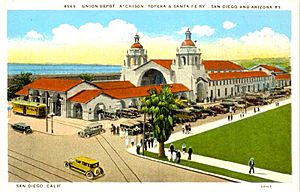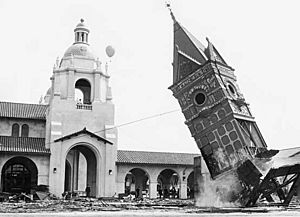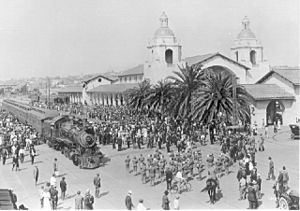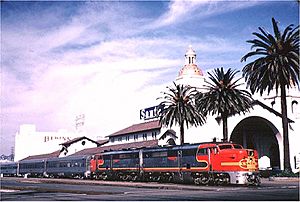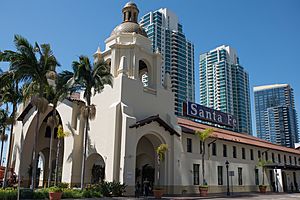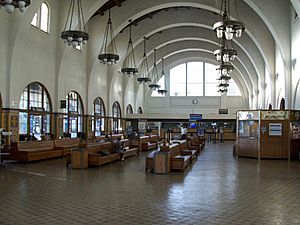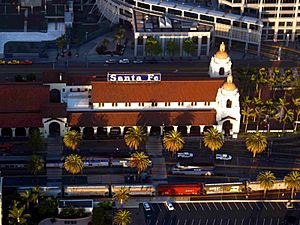Santa Fe Depot (San Diego) facts for kids
Quick facts for kids
Santa Fe Depot
San Diego, CA |
|||||||||||||||||||||||||||||||
|---|---|---|---|---|---|---|---|---|---|---|---|---|---|---|---|---|---|---|---|---|---|---|---|---|---|---|---|---|---|---|---|
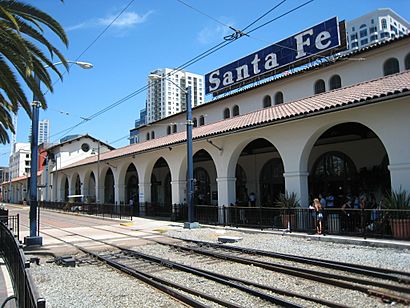
The station building as seen from the platforms in August 2007
|
|||||||||||||||||||||||||||||||
| Other names | Union Station | ||||||||||||||||||||||||||||||
| Location | 1050 Kettner Boulevard, San Diego, California United States |
||||||||||||||||||||||||||||||
| Coordinates | 32°43′00″N 117°10′10″W / 32.71667°N 117.16944°W | ||||||||||||||||||||||||||||||
| Owned by | Santa Fe Depot LLC (building) North County Transit District (tracks) |
||||||||||||||||||||||||||||||
| Operated by | Amtrak | ||||||||||||||||||||||||||||||
| Line(s) | Surf Line | ||||||||||||||||||||||||||||||
| Platforms | 2 island platforms 2 side platforms |
||||||||||||||||||||||||||||||
| Tracks | 6 | ||||||||||||||||||||||||||||||
| Connections | |||||||||||||||||||||||||||||||
| Construction | |||||||||||||||||||||||||||||||
| Structure type | At-grade | ||||||||||||||||||||||||||||||
| Parking | Metered | ||||||||||||||||||||||||||||||
| Disabled access | |||||||||||||||||||||||||||||||
| Other information | |||||||||||||||||||||||||||||||
| Station code | SAN (Amtrak) 75082, 75083 (MTS) |
||||||||||||||||||||||||||||||
| Fare zone | 3 (COASTER) | ||||||||||||||||||||||||||||||
| History | |||||||||||||||||||||||||||||||
| Opened | March 7, 1915 | ||||||||||||||||||||||||||||||
| Rebuilt | October 2012 | ||||||||||||||||||||||||||||||
| Original company | Atchison, Topeka and Santa Fe Railway | ||||||||||||||||||||||||||||||
| Traffic | |||||||||||||||||||||||||||||||
| Passengers (2018) | 699,430 |
||||||||||||||||||||||||||||||
| Rank | 3rd in California | ||||||||||||||||||||||||||||||
| Services | |||||||||||||||||||||||||||||||
|
|||||||||||||||||||||||||||||||
|
|||||||||||||||||||||||||||||||
|
Santa Fe Depot
|
|||||||||||||||||||||||||||||||
| Location | 1050 Kettner St., San Diego, California | ||||||||||||||||||||||||||||||
| Area | 4.6 acres (1.9 ha) | ||||||||||||||||||||||||||||||
| Built | 1915 | ||||||||||||||||||||||||||||||
| Architect | Bakewell and Brown | ||||||||||||||||||||||||||||||
| Architectural style | Mission/spanish Revival | ||||||||||||||||||||||||||||||
| NRHP reference No. | 72000248 | ||||||||||||||||||||||||||||||
| Significant dates | |||||||||||||||||||||||||||||||
| Added to NRHP | June 26, 1972 | ||||||||||||||||||||||||||||||
The Santa Fe Depot in San Diego, California, is a historic train station. It was built by the Atchison, Topeka and Santa Fe Railway. The station replaced an older, smaller building from 1887. Its design is in the Spanish Colonial Revival style. This style is often seen in other buildings in Downtown San Diego. The station is listed on the National Register of Historic Places. Today, a part of the building holds the downtown branch of the Museum of Contemporary Art San Diego.
The Santa Fe Depot officially opened on March 8, 1915. It was built to welcome visitors to the Panama-California Exposition. This was a very hopeful time for San Diego. The city wanted to be the main train stop on the West Coast for the Santa Fe Railway. However, Los Angeles eventually won this competition. The station is now listed on the National Register of Historic Places.
In the past, the station served trains from the Santa Fe, San Diego and Arizona Railway (SD&A), and San Diego Electric Railway (SDERy). It was even called "San Diego Union Station" for a while. This was after the SD&A finished its own cross-country line in 1919. The Santa Fe company took over the station again in 1951. This happened when the SD&A's passenger service stopped. The SDERy had also stopped running a few years before.
This old station is in the heart of Downtown San Diego. It is still a busy transportation hub. It serves Amtrak trains, the COASTER commuter train, the San Diego Trolley, and local buses. In 2013, the Santa Fe Depot was the third busiest Amtrak station in California. It was also the 13th busiest in the entire Amtrak system. About 1,880 passengers used it every day.
Contents
History of the San Diego Train Station
Early Railroads in San Diego
In the late 1800s, San Diego wanted a direct train link to the eastern United States. The Texas and Pacific Railway tried to build a line to San Diego. But it never reached the city. Instead, it met another railroad in Texas.
After this, a group called the Citizens Railroad Committee of San Diego formed. They wanted to build a train line to connect with the Santa Fe Railway. The Santa Fe helped them financially. This group also started the California Southern Railroad Company (CSRR) in 1880. They built train facilities in National City, a suburb of San Diego. This included a roundhouse and yards for sorting trains.
Train tracks were built north from National City. By 1882, the California Southern started passenger and freight service. It ran between National City and Fallbrook Junction. The tracks continued north and connected with the Southern Pacific's line in Colton in 1882. The California Southern later extended its line to San Bernardino. In 1885, this line became part of the Santa Fe Railroad's cross-country route.
The "Surf Line" and New Depot
The Santa Fe completed a coastal train route between Los Angeles and San Diego in 1888. This route was called the "Surf Line." It was a shorter way to travel than the older inland route.
A big real estate boom in 1887 brought many people to Southern California. Most traveled on the Santa Fe. The California Southern built a new Victorian-style station to handle all these visitors. But floods often damaged the inland route. So, Santa Fe started building the 126-mile (203 km) "Surf Line" along the coast. This new coastal route became the only way to reach San Diego from the north by 1891.
People thought San Diego would become a major port after the Panama Canal opened in 1914. The city planned a big international fair to celebrate this. But San Diego was 100 miles (160 km) farther south than Los Angeles. This meant an extra day of travel for trains. Santa Fe moved its main port operations to San Pedro in 1911. This ended San Diego's hopes of being the main port on the West Coast.
Building the Santa Fe Depot
The old station was not big enough for the many visitors expected for the 1915 Exposition. So, Santa Fe decided to build a new, larger station. Plans for the new station were made in the Mission Revival Style. This style matched the Exposition buildings. Construction began on January 15, 1914. It cost about $300,000. The new station opened on March 8, 1915. The old wooden station was torn down just before.
When it opened, Santa Fe had three local trains and one express train daily between Los Angeles and San Diego. During the Exposition, there were nine scheduled trains on weekdays. On weekends, twelve trains ran.
The San Diego Electric Railway (SDERy) also had stops at the station. This continued until 1949, when San Diego switched to an all-bus system. The San Diego and Arizona Railway (SD&A) also used the station. This railway connected San Diego to the east. The first SD&A passenger train arrived in downtown San Diego on December 1, 1919.
In 1938, Santa Fe started a new train route called the San Diegan. It ran between Los Angeles and San Diego. By 1941, there were four round trips daily. During World War II, train traffic increased a lot. This was for moving troops and military supplies.
After the war, passenger numbers stayed high. The "Surf Line" was one of the busiest train lines in the U.S. Passenger service on the San Diego and Arizona Eastern Railway ended in 1951. In 1954, the front entrance of the station was changed to make a parking lot.
On May 1, 1971, Amtrak took over the San Diegan line. This train ran between Santa Fe Depot and Union Station in Los Angeles. In 1972, Santa Fe wanted to tear down the station. They planned to build two tall buildings instead. But people protested, and Amtrak agreed to save the station. The San Diegan train was later renamed the Pacific Surfliner. This name reflects its longer route along the coast.
Station Design and Look
The Santa Fe Depot was designed by architects Bakewell and Brown. They wanted it to remind people of California's Spanish history. The Mission Revival style matches the Spanish Colonial Revival Style buildings of the Panama-California Exposition. The station was very large and grand for its time. It had a long covered walkway and a big waiting room.
The main entrance has a huge arch. It is flanked by two tall towers. Each tower has a colorful tile-covered dome. They also show Santa Fe's blue "cross" symbol. The building's design is inspired by the Mission San Luis Rey de Francia. This mission is in Oceanside, north of San Diego. The inside of the station has natural redwood beam ceilings. The walls are covered with bright ceramic tiles. These tiles have detailed Spanish and Moorish designs. They are in green, yellow, blue, white, and black colors.
Trains and Services Today
Today, the Santa Fe Depot is a busy place for different types of transportation. It still has most of its original features. This includes the big blue-and-white "Santa Fe" sign. It also has the original, hundred-year-old oak benches.
San Diego Trolley Service
The San Diego Trolley is a modern light rail system. It started running on July 26, 1981. The station was its northern end point. In 1991, the Trolley line was extended. The Trolley system has continued to grow since then.
The Trolley part of the station was updated from May to October 2012. This was part of a project to renew the Trolley system.
The Santa Fe Depot is served only by the Trolley's Green Line. But passengers can easily switch to the Blue Line and Orange Line trains. These are at the America Plaza station across the street. Because they are so close, the Metropolitan Transit System calls them the "Santa Fe Transit Center."
Commuter and Intercity Trains
The Santa Fe Depot is the southern end for the NCTD COASTER commuter train service. This service started on weekdays in 1995. The station is about 41 miles (66 km) from the COASTER's northern end in Oceanside.
The station is also the southern end for Amtrak's Pacific Surfliner train. This train is the successor to the San Diegan. It runs from San Diego through Los Angeles to San Luis Obispo. Most trains run along the "Surf Line" from San Diego to Los Angeles. This is the second busiest train corridor in the United States.
Amtrak passenger numbers at Santa Fe Depot have changed over the years. They reached a high of 777,961 passengers in 2017.
Daily freight trains also pass through the station. They are operated by BNSF. These trains often run at night when there are fewer passenger trains. The BNSF freight yard in San Diego is about 2 miles (3.2 km) south of the station.
Station Layout and Tracks
The Santa Fe Depot has six tracks. The two tracks on the east side are for Trolley service. The other tracks are used by both commuter and intercity trains. BNSF freight trains also use these tracks. They pass through the station to go south to the freight yards or north away from San Diego.
Future Plans for the Station
The station was once considered as the southern end for the planned California High-Speed Rail system. If built, passengers could travel to Los Angeles Union Station in just 1 hour and 18 minutes. However, newer plans suggest a different southern end. This would be a new transit center near San Diego International Airport. It is planned to be built by 2035. Extending the high-speed rail line into downtown San Diego was thought to be too difficult.
Station Photos
Images for kids
See also
 In Spanish: Union Station (San Diego) para niños
In Spanish: Union Station (San Diego) para niños


